CHEVROLET CAMARO 1994 4.G Owners Manual
Manufacturer: CHEVROLET, Model Year: 1994, Model line: CAMARO, Model: CHEVROLET CAMARO 1994 4.GPages: 292, PDF Size: 15.35 MB
Page 141 of 292
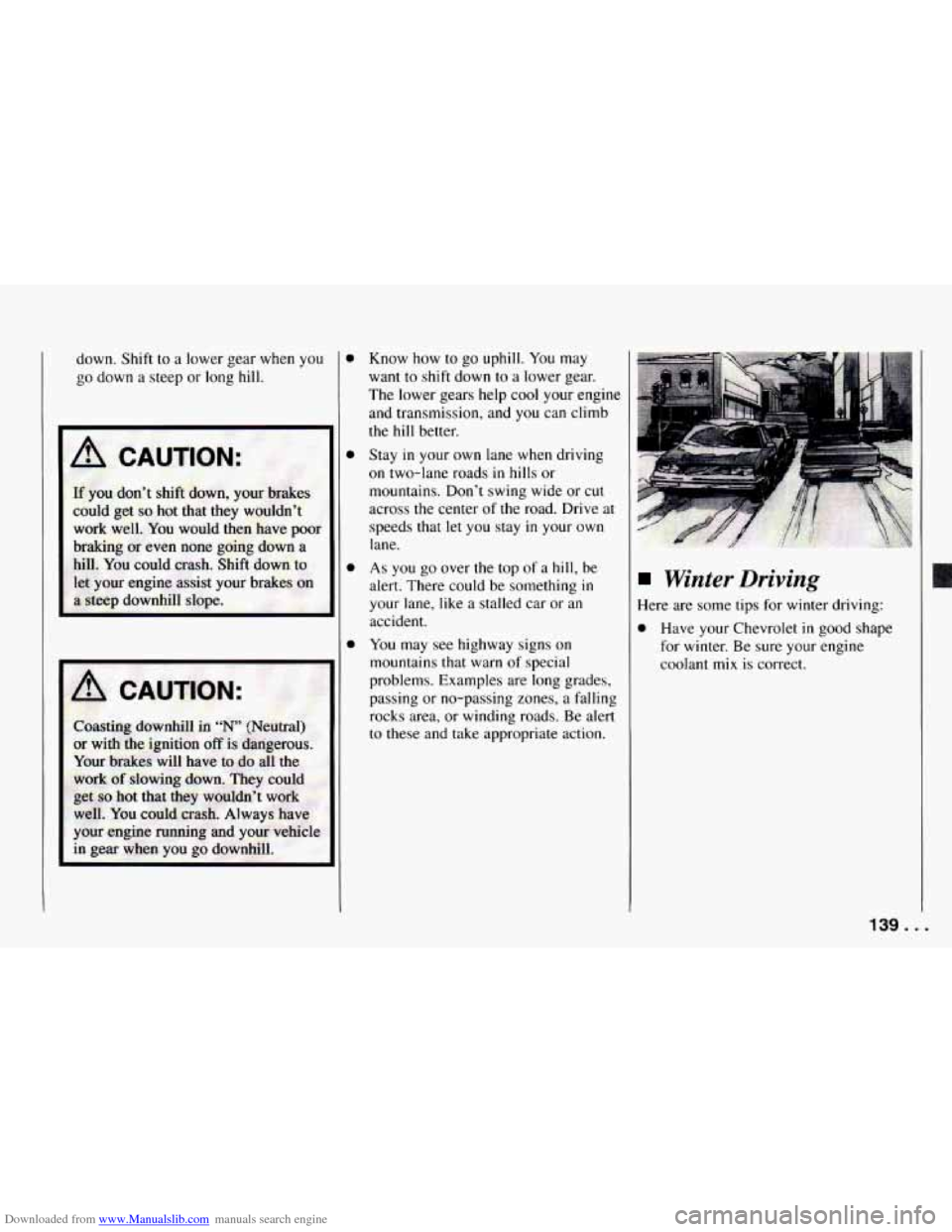
Downloaded from www.Manualslib.com manuals search engine down. Shift to a lower gear when you
go down a steep or long hill.
If you don’t shift down, your brakes
could get so hot that they wouldn’t
work well. You would then have
poor
braking or even none going down a
hill. You could crash. Shift down to
let your engine assist your brakes on
a steep downhill slope.
I
m
Know how to go uphill. You may
want
to shift down to a lower gear.
The lower gears help cool your engine
and transmission, and you can climb
the
hill better.
Stay
in your own lane when driving
on two-lane roads
in hills or
mountains. Don’t swing wide or cut
across the center
of the road. Drive at
speeds that let you stay
in your own
lane.
As you go over the top of a hill, be
alert. There could be something
in
your lane, like a stalled car or an
accident.
You may see highway signs on
mountains that warn of special
problems. Examples are long grades,
passing or no-passing zones, a falling
rocks area, or winding roads. Be alert
to these and take appropriate action.
Winter Driving
Here are some tips for winter driving:
0 Have your Chevrolet in good shape
for winter. Be sure your engine
coolant
mix is correct.
139 ...
Page 142 of 292
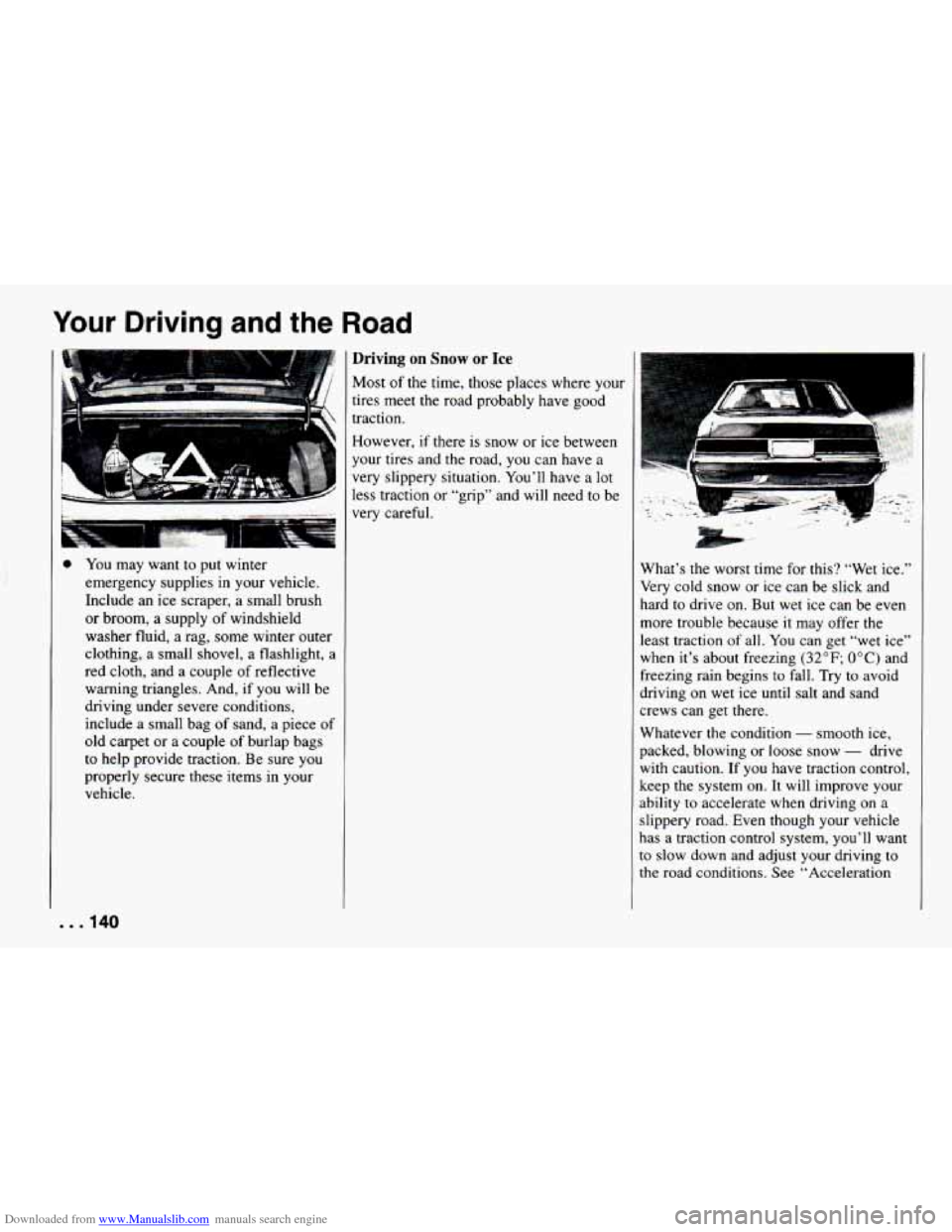
Downloaded from www.Manualslib.com manuals search engine Your Driving and the Road
I
;i”iii’ i ;i7: ,,:: : . .
0 You may want to put winter
emergency supplies in your vehicle.
Include an ice scraper, a small brush
or broom, a supply of windshield
washer
fluid, a rag, some winter outer
clothing, a small shovel,
a flashlight, a
red cloth, and a couple of reflective
warning triangles. And, if you
will be
driving under severe conditions,
include a small bag of sand, a piece of
old carpet or a couple of burlap bags
to help provide traction. Be sure you
properly secure these items
in your
vehicle.
Driving on Snow or Ice
Most of the time, those places where your
tires meet the road probably have good
traction.
However, if there is snow or ice between
your tires and the road, you can have a
very slippery situation. You’ll have a lot
less traction
or “grip” and will need to be
very careful. P. :’
$;.,
What’s the worst time for this? “Wet ice.”
Very cold snow or ice can be slick and
hard to drive on. But wet ice can be even
more trouble because
it may offer the
least traction of all.
You can get “wet ice”
when it’s about freezing
(32°F; OOC) and
freezing rain begins to fall. Try to avoid
driving on wet ice until salt and sand
crews can get there.
Whatever the condition
- smooth ice,
packed, blowing or loose snow
- drive
with caution.
If you have traction control,
keep the system on.
It will improve your
ability to accelerate when driving on a
slippery road. Even though your vehicle
has a traction control system, you’ll want
to slow down and adjust your driving to
the road conditions. See “Acceleration
. . .I40
Page 143 of 292
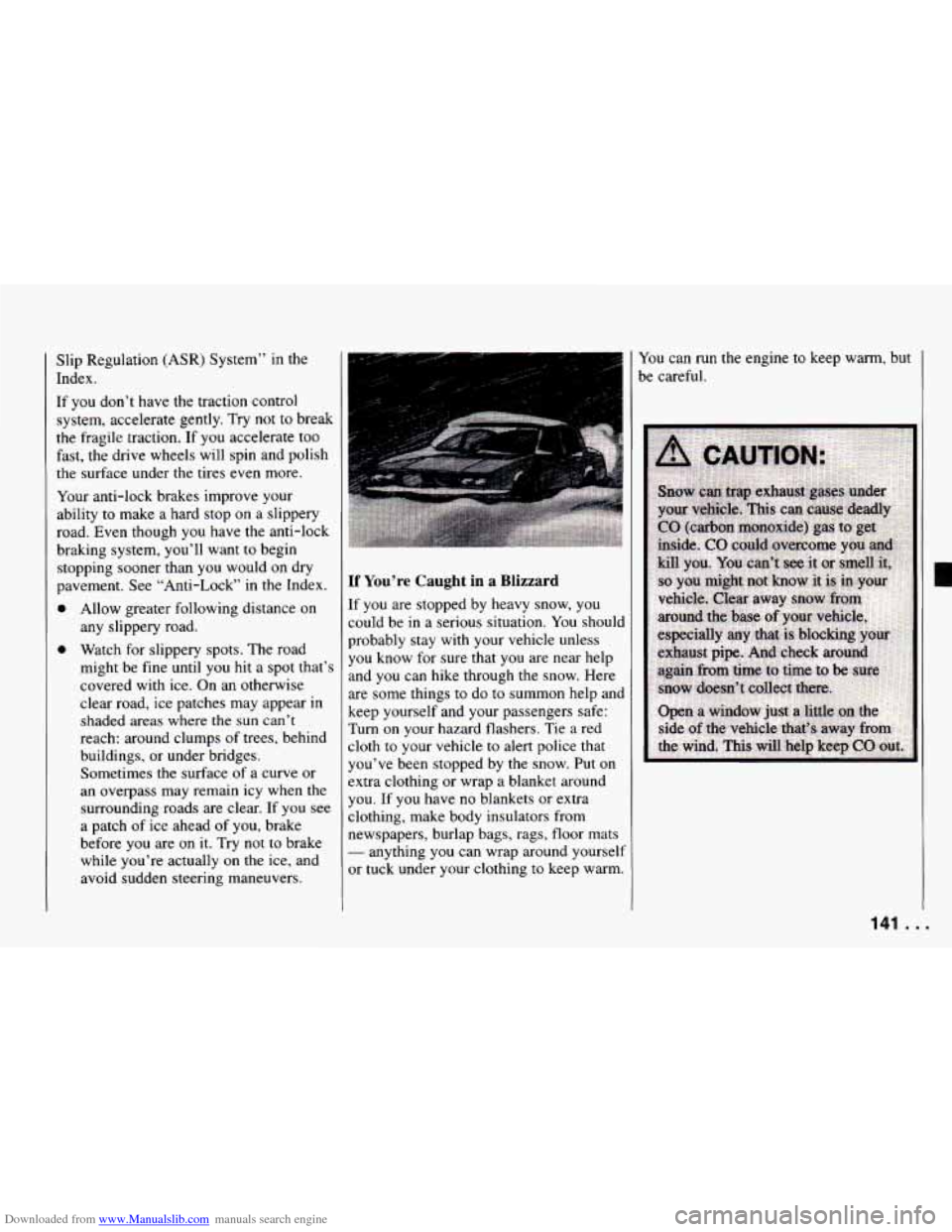
Downloaded from www.Manualslib.com manuals search engine Slip Regulation (ASR) System” in the
Index.
If you don’t have the traction control
system, accelerate gently. Try not to break
the fragile traction. If you accelerate too
fast, the drive wheels will spin and polish
the surface under the tires even more.
Your anti-lock brakes improve your
ability to make a hard stop on a slippery
road. Even though you have the anti-lock
braking system, you’ll want to begin
stopping sooner
than you would on dry
pavement. See “Anti-Lock” in
the Index.
0
0
Allow greater following distance on
any slippery road.
Watch for slippery spots. The road
might be fine until you hit a spot that’s
covered with ice. On an otherwise
clear road, ice patches may appear
in
shaded areas where the sun can’t
reach: around clumps of trees, behind
buildings, or under bridges.
Sometimes the surface
of a curve or
an overpass may remain icy when the
surrounding roads are clear. If you see
a patch of ice ahead of you, brake
before you are on
it. Try not to brake
while you’re actually on the ice, and
avoid sudden steering maneuvers.
If You’re Caught in a Blizzard
If you are stopped by heavy snow, you
could be
in a serious situation. You should
probably stay with your vehicle unless
you know for sure that you are near help
and you can hike through
the snow. Here
are some things to do to summon help and
keep yourself and your passengers safe:
Turn on your hazard flashers. Tie a red
cloth to your vehicle to alert police that
you’ve been stopped by the snow. Put
on
extra clothing or wrap a blanket around
you. If you have no blankets or extra
clothing, make body insulators from
newspapers, burlap bags, rags, floor mats
- anything you can wrap around yourself
or tuck under your clothing to keep warm.
You can run the engine to keep warrn, but
be careful.
141 . I
Page 144 of 292
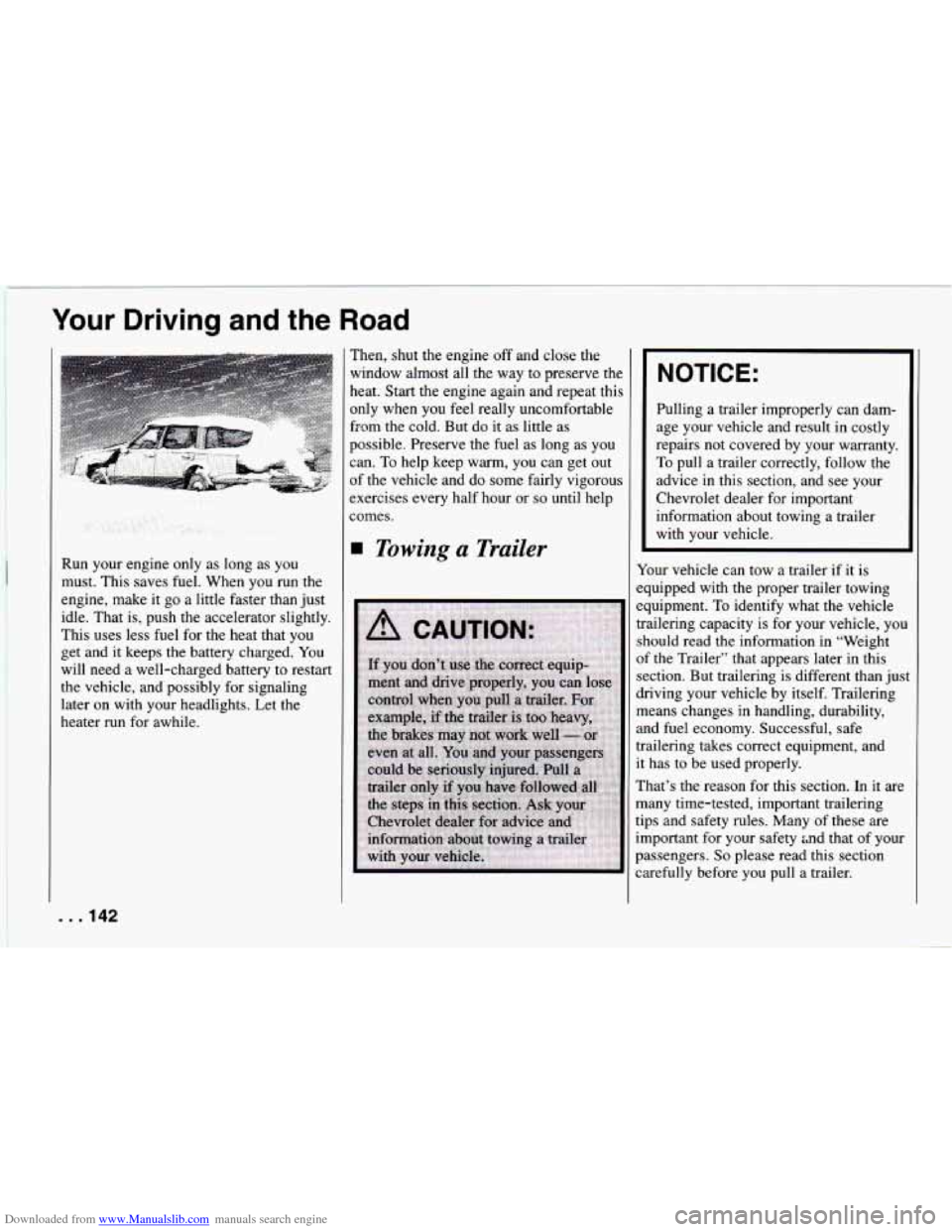
Downloaded from www.Manualslib.com manuals search engine Your Driving and the Road
Run your engine only as long as you
must. This saves fuel. When you run the
engine, make it go a little faster than just
idle. That is, push the accelerator slightly.
This uses less fuel for the heat that you
get and it keeps the battery charged.
You
will need a well-charged battery to restart
the vehicle, and possibly for signaling
later on with your headlights. Let the
heater run for awhile. Then,
shut the engine
off and close the
window almost all the way to preserve the
heat. Start the engine again and repeat this
only when you feel really uncomfortable
from the cold. But do it as little as
possible. Preserve the fuel as long as you
can. To help keep warm, you can get out
of the vehicle and do some fairly vigorous
exercises every half hour or
so until help
comes.
Towing a Trailer
NOTICE:
Pulling a trailer improperly can dam-
age your vehicle and result in costly
repairs not covered
by your warranty.
To pull a trailer correctly, follow the
advice
in this section, and see your
Chevrolet dealer for important
information about towing a trailer
with your vehicle.
Your vehicle can tow a trailer if it is
equipped with the proper trailer towing
equipment. To identify what the vehicle
trailering capacity is for your vehicle, you
should read the information in “Weight
of the Trailer” that appears later in this
section. But trailering is different than just
driving your vehicle by itself. Trailering
means changes in handling, durability,
and fuel economy. Successful, safe
trailering takes correct equipment, and
it has to be used properly.
That’s the reason for this section. In it are
many time-tested, important trailering
tips and safety rules. Many of these are
important for your safety md that of your
passengers.
So please read this section
carefully before you pull a trailer.
. . .142
Page 145 of 292
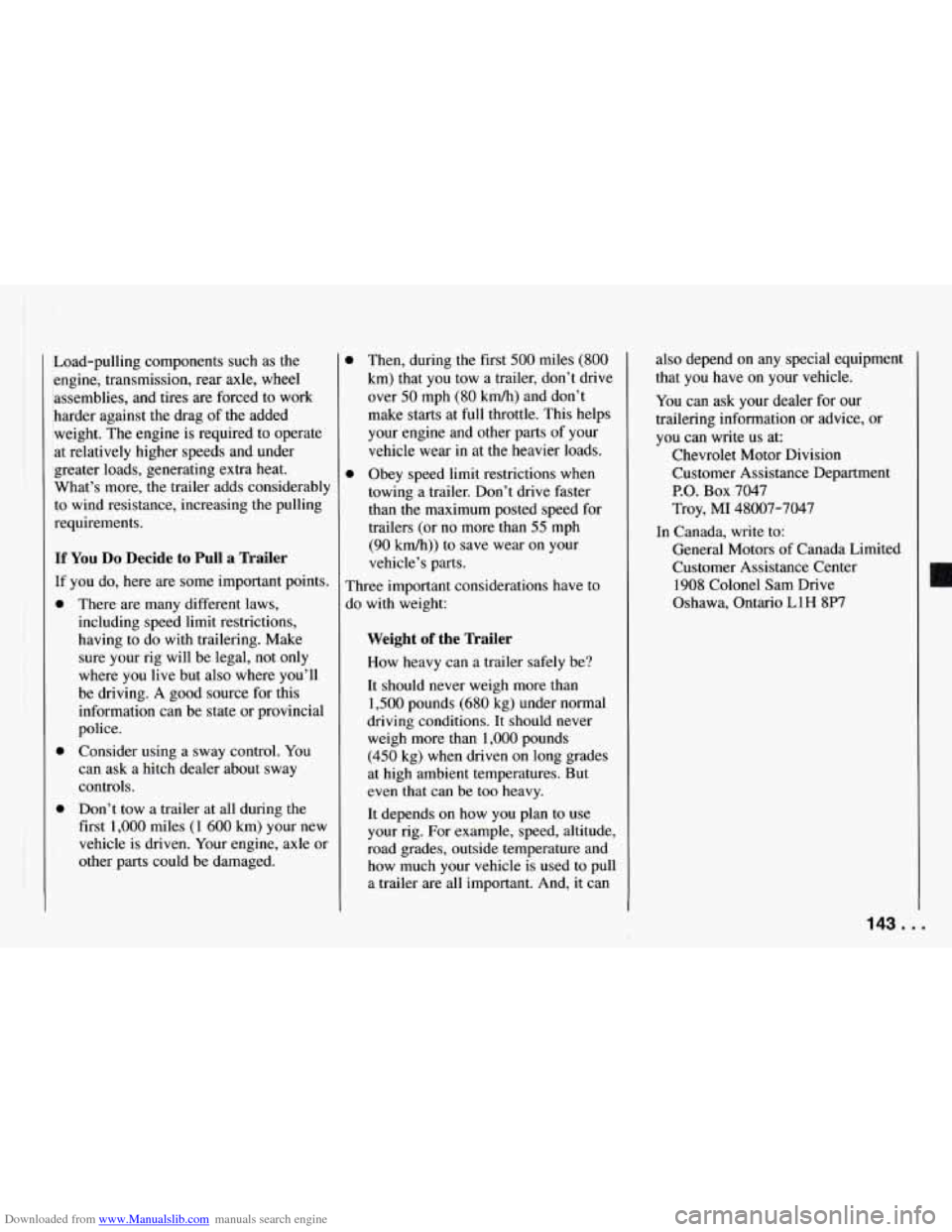
Downloaded from www.Manualslib.com manuals search engine t
Load-pulling components such as the
engine, transmission, rear axle, wheel
assemblies, and tires are forced to work
harder against the drag
of the added
weight, The engine
is required to operate
at relatively higher speeds and under
greater loads, generating extra heat.
What’s more, the trailer adds considerably
to wind resistance, increasing the pulling
requirements.
If You Do Decide to Pull a Trailer
If you do, here are some important points.
0
0
0
There are many different laws,
including speed limit restrictions,
having to do with trailering. Make
sure your rig will be legal, not only
where you live but also where you’ll
be driving. A good source for this
information can be state or provincial
police.
Consider using a sway control.
You
can ask a hitch dealer about sway
controls.
Don’t tow a trailer at all during the
first
1,000 miles (1 600 km) your new
vehicle is driven. Your engine, axle or
other parts could be damaged. Then, during
the first
500 miles (800
km) that you tow a trailer, don’t drive
over
50 mph (80 km/h) and don’t
make starts at full throttle. This helps
your engine and other parts of your
vehicle wear in at the heavier loads.
Obey speed limit restrictions when
towing a trailer. Don’t drive faster
than the maximum posted speed for
trailers (or no more than
55 mph
(90 km/h)) to save wear on your
vehicle’s parts.
Three important considerations have to
do with weight:
Weight of the Trailer
How heavy can a trailer safely be? also depend on
any special equipment
I
that you have on your vehicle.
You can ask your dealer for our
trailering information or advice, or
you can write
us at:
Chevrolet Motor Division Customer Assistance Department
P.O. Box 7047
Troy, MI 48007-7047
General Motors
of Canada Limited
Customer Assistance Center
1908 Colonel Sam Drive
Oshawa, Ontario
LlH 8P7
In Canada, write to:
It should never weigh more than
1,500 pounds (680 kg) under normal
driving conditions.
It should never
weigh more than
1,000 pounds
(450 kg) when driven on long grades
at high ambient temperatures. But
even that can be
too heavy.
It depends on how you plan to use
your rig. For example, speed, altitude,
road grades, outside temperature and
how much your vehicle is used to pull
a trailer are all important. And, it can
143. ..
Page 146 of 292
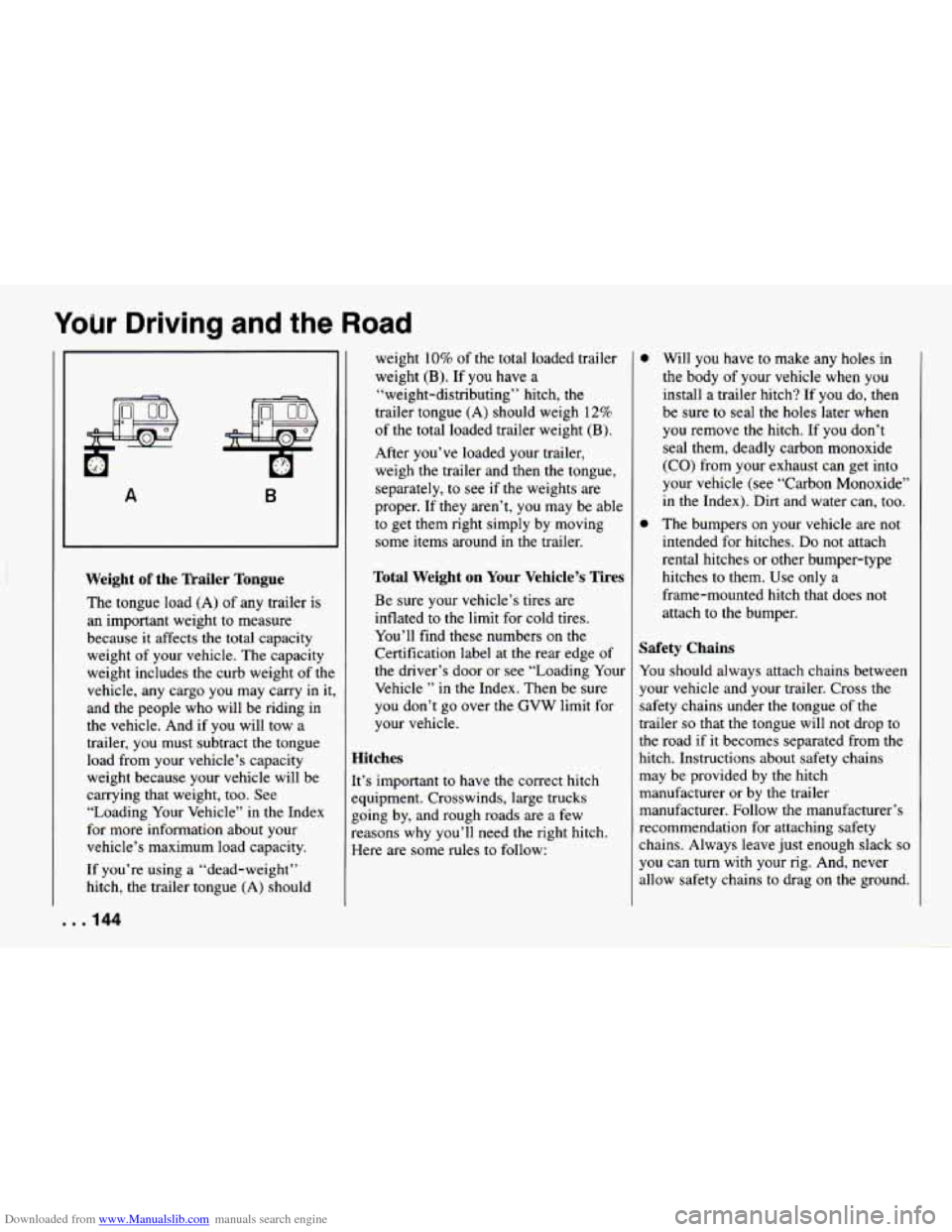
Downloaded from www.Manualslib.com manuals search engine Your Driving and the Road
A B
Weight of the Trailer Tongue
The tongue load (A) of any trailer is
an important weight to measure
because it affects the total capacity
weight of your vehicle. The capacity
weight includes the curb weight of the
vehicle, any cargo you may carry in it.
and the people who will be riding in
the vehicle. And if you will tow a
trailer, you must subtract the tongue
load from your vehicle’s capacity
weight because your vehicle will be
carrying that weight, too. See “Loading Your Vehicle” in the Index
for more information about your
vehicle’s maximum load capacity.
If you’re using a “dead-weight’’
hitch, the trailer tongue
(A) should
. .I44
weight 10% of the total loaded trailer
weight (B). If you have a
“weight-distributing” hitch,
the
trailer tongue (A) should weigh 12%
of the total loaded trailer weight
(B).
After you’ve loaded your trailer,
weigh the trailer and then the tongue,
separately, to see if the weights are
proper. If they aren’t, you may be able
to get them
right simply by moving
some items around in the trailer.
Total Weight on Your Vehicle’s Tires
Be sure your vehicle’s tires are
inflated to the limit for cold tires.
You’ll find these numbers on the
Certification label at
the rear edge of
the driver’s door or see “Loading Your
Vehicle
” in the Index. Then be sure
you don’t go over the GVW limit for
your vehicle.
Hitches
It’s important to have the correct hitch
zquipment. Crosswinds, large trucks
going by, and rough roads are a few
reasons why you’ll need the right hitch.
Here are some rules to follow:
Will you have to make any holes in
the body
of your vehicle when you
install a trailer hitch? If you do, then
be sure to seal the holes later when
you remove the hitch. If you don’t
seal them, deadly carbon monoxide
(CO) from your exhaust can get into
your vehicle (see “Carbon Monoxide”
in the Index). Dirt and water can, too.
The bumpers on your vehicle are not
intended for hitches.
Do not attach
rental hitches or other bumper-type
hitches to them. Use only a
frame-mounted hitch that does not
attach to the bumper.
Safety Chains
You should always attach chains between
your vehicle and your trailer. Cross the
safety chdins under the tongue of the
trailer
so that the tongue will not drop to
the road if it becomes separated from the
hitch. Instructions about safety chains
may be provided by the hitch
manufacturer or by the trailer
manufacturer. Follow the manufacturer’s
recommendation for attaching safety
chains. Always leave just enough slack
so
you can turn with your rig. And, never
allow safety chains to drag on the ground.
Page 147 of 292
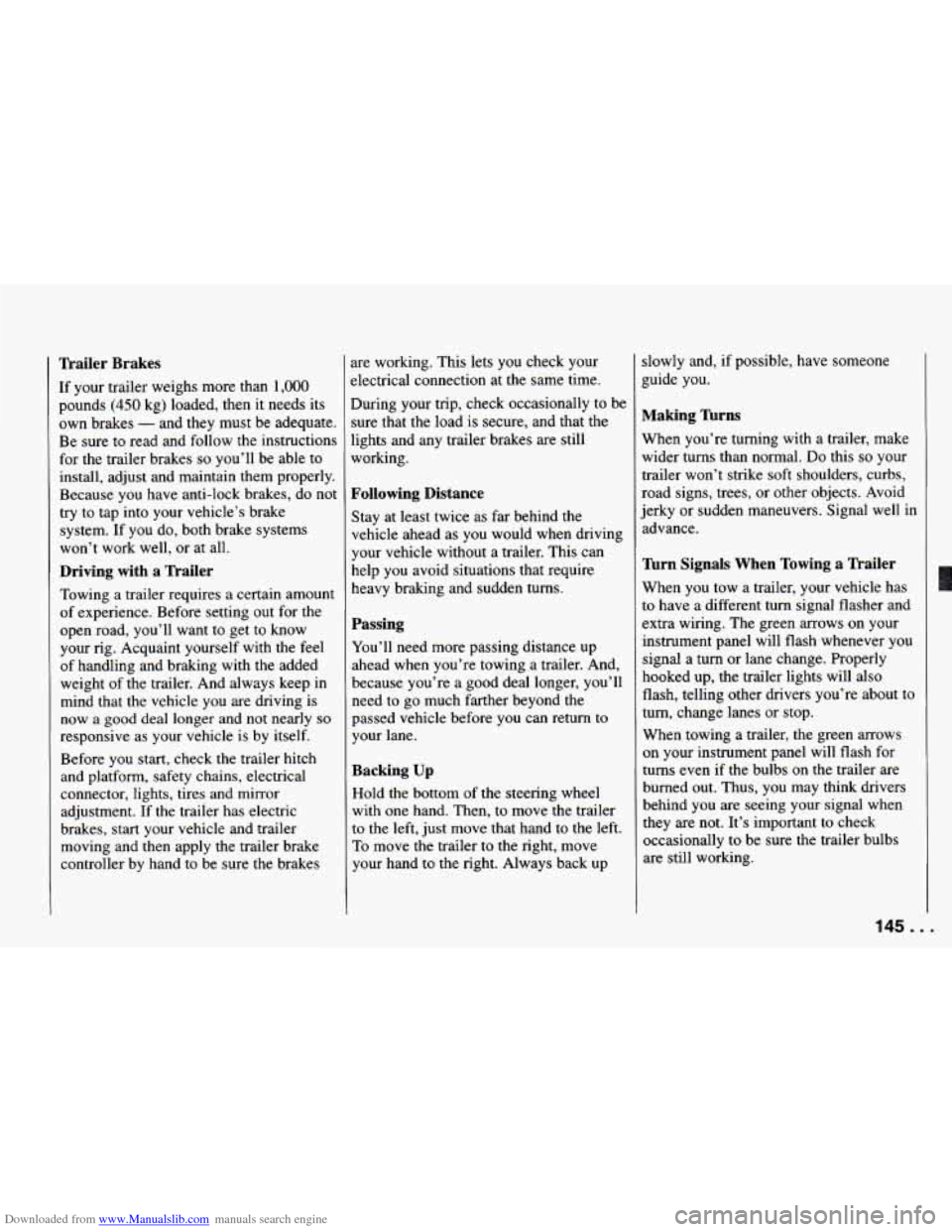
Downloaded from www.Manualslib.com manuals search engine Trailer Brakes
If your trailer weighs more than 1,000
pounds (450 kg) loaded, then it needs its
own brakes
- and they must be adequate.
Be sure to read and follow the instructions
for the trailer brakes
so you’ll be able to
install, adjust and maintain them properly.
Because you have anti-lock brakes, do not
try to tap into your vehicle’s brake
system. If you do, both brake systems
won’t work well, or at all.
Driving with a Trailer
Towing a trailer requires a certain amount
of experience. Before setting out for the
open road, you’ll want to get to know
your rig. Acquaint yourself with the feel
of handling and braking with the added
weight of the trailer. And always keep in
mind that the vehicle you are driving is
now
a good deal longer and not nearly so
responsive as your vehicle is by itself.
Before you start, check the trailer hitch
and platform, safety chains, electrical
connector, lights, tires and mirror
adjustment. If the trailer has electric
brakes, start your vehicle and trailer
moving and then apply the trailer brake
controller by hand to be sure
the brakes are working.
This lets
you check your
electrical connection at the same time.
During your trip, check occasionally to be sure that the load is secure, and that
the
lights and any trailer brakes are still
working.
Following Distance
Stay at least twice as far behind the
vehicle ahead as you would when driving
your vehicle without a trailer. This can
help you avoid situations that require
heavy braking and sudden turns.
Passing
You’ll need more passing distance up
ahead when you’re towing a trailer. And,
because you’re a good deal longer, you’ll need to go much farther beyond the
passed vehicle before you can return
to
your lane.
Backing Up
Hold the bottom of the steering wheel
with one hand. Then, to move the trailer
to the left, just move that hand to the left.
To move the trailer to the right, move
your hand to the right. Always back up slowly
and, if possible, have someone
guide you.
Making Turns
When you’re turning with a trailer, make
wider turns than normal.
Do this so your
trailer won’t strike soft shoulders, curbs,
road signs, trees, or other objects. Avoid
jerky or sudden maneuvers. Signal well in
advance.
Turn Signals When Towing a Trailer
When you tow a trailer, your vehicle has
to have a different turn signal flasher and
extra wiring. The green arrows on your
instrument panel will flash whenever you
signal a turn or lane change. Properly
hooked up, the trailer lights will also
flash, telling other drivers you’re about to
turn, change lanes or stop.
When towing a trailer, the green arrows
Dn your instrument panel will flash for
turns even if the bulbs on the trailer are
burned out. Thus, you may think drivers
behind you
are seeing your signal when
they are not. It’s important to check
occasionally to be sure the trailer bulbs
are still working.
145. I
Page 148 of 292
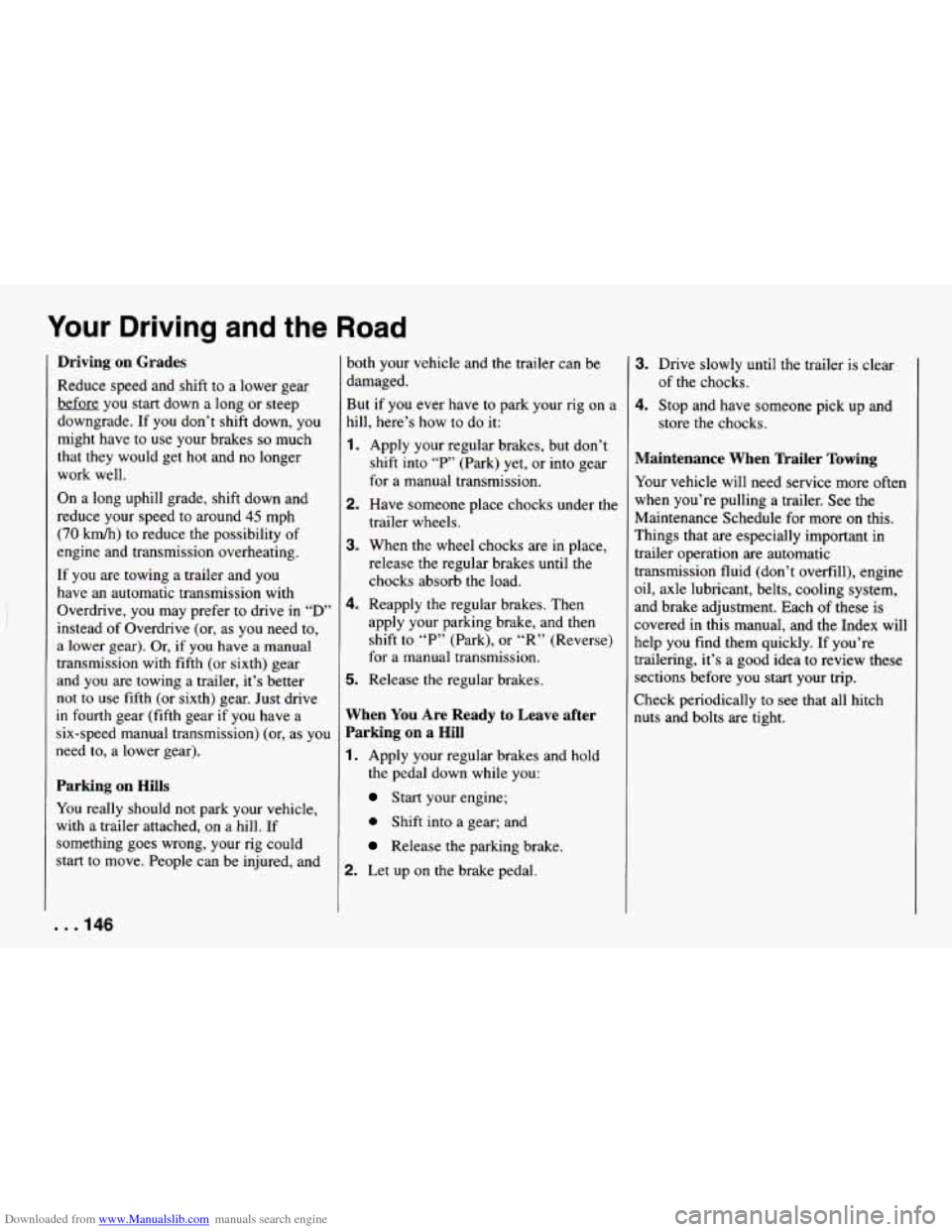
Downloaded from www.Manualslib.com manuals search engine Your Driving and the Road
Driving on Grades
Reduce speed and shift to a lower gear
before you start down a long or steep
downgrade. If you don’t shift down, you
might have to use your brakes
so much
that they would get hot and no longer
work well.
On a long uphill grade, shift down and
reduce your speed to around
45 mph
(70 kmh) to reduce the possibility of
engine and transmission overheating.
If you are towing a trailer and you
have an automatic transmission with
Overdrive, you may prefer to drive
in “D’
instead of Overdrive (or, as you need to,
a lower gear). Or,
if you have a manual
transmission with fifth (or sixth) gear
and you are towing a trailer, it’s better
not to use fifth (or sixth) gear. Just drive
in fourth gear (fifth gear if you have a
six-speed manual transmission) (or, as you
need to, a lower gear).
Parking on Hills
You really should not park your vehicle,
with a trailer attached, on a
hill. If
something goes wrong, your rig could
start to move. People can be injured, and both your vehicle and the trailer can be
damaged.
But if you
ever have to park your
rig on a
hill, here’s how to do it:
1. Apply your regular brakes, but don’t
shift into
“P’ (Park) yet, or into gear
for a manual transmission.
2. Have someone place chocks under the
3. When the wheel chocks are in place,
release the regular brakes until the
chocks absorb the load.
trailer wheels.
4. Reapply the
regular brakes. Then
apply your parking brake, and then
shift to
“P” (Park), or “R” (Reverse)
for a manual transmission.
5. Release the regular brakes.
When You Are Ready to Leave after
Parking on a Hill
1. Apply your regular brakes and hold
the pedal down while you:
Start your engine;
0 Shift into a gear; and
Release the parking brake.
2. Let up on the brake pedal.
3. Drive slowly until the trailer is clear
4. Stop ahd have someone pick up and
of the
chocks.
store the chocks.
Maintenance When Trailer Towing
Your vehicle will need service more often
when you’re pulling a trailer. See the
Maintenance Schedule for more on this.
Things that are especially important in
trailer operation are automatic
transmission fluid (don’t overfill), engine
oil, axle lubricant, belts, cooling system,
and brake adjustment. Each of these is
covered in this manual, and
the Index will
help you find them quickly. If you’re
trailering, it’s a good idea to review these
sections before you start your
trip.
Check periodically to see that all hitch
nuts and bolts are tight.
. . ,146
Page 149 of 292
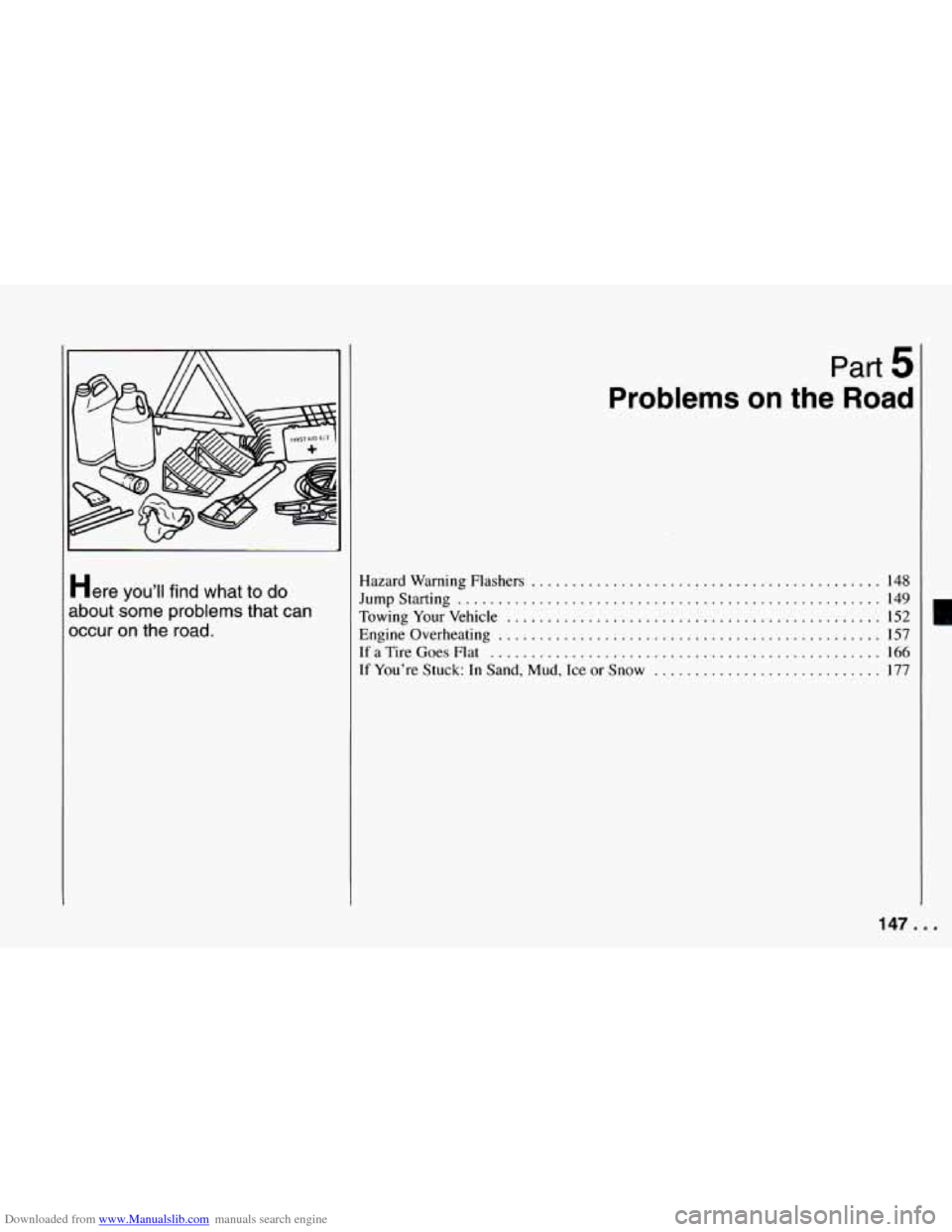
Downloaded from www.Manualslib.com manuals search engine I'
J
Here you'll find what to do
about some problems that can
occur
on the road .
Part 5
Problems on the Road
Hazard Warning Flashers ........................................... 148
Jumpstarting .................................................... 149
TowingYourVehicle .............................................. 152
Engineoverheating
............................................... 157
IfaTireGoesFlat
................................................ 166
If You're Stuck: In Sand, Mud, Ice or Snow ............................ 177
147 .
Page 150 of 292
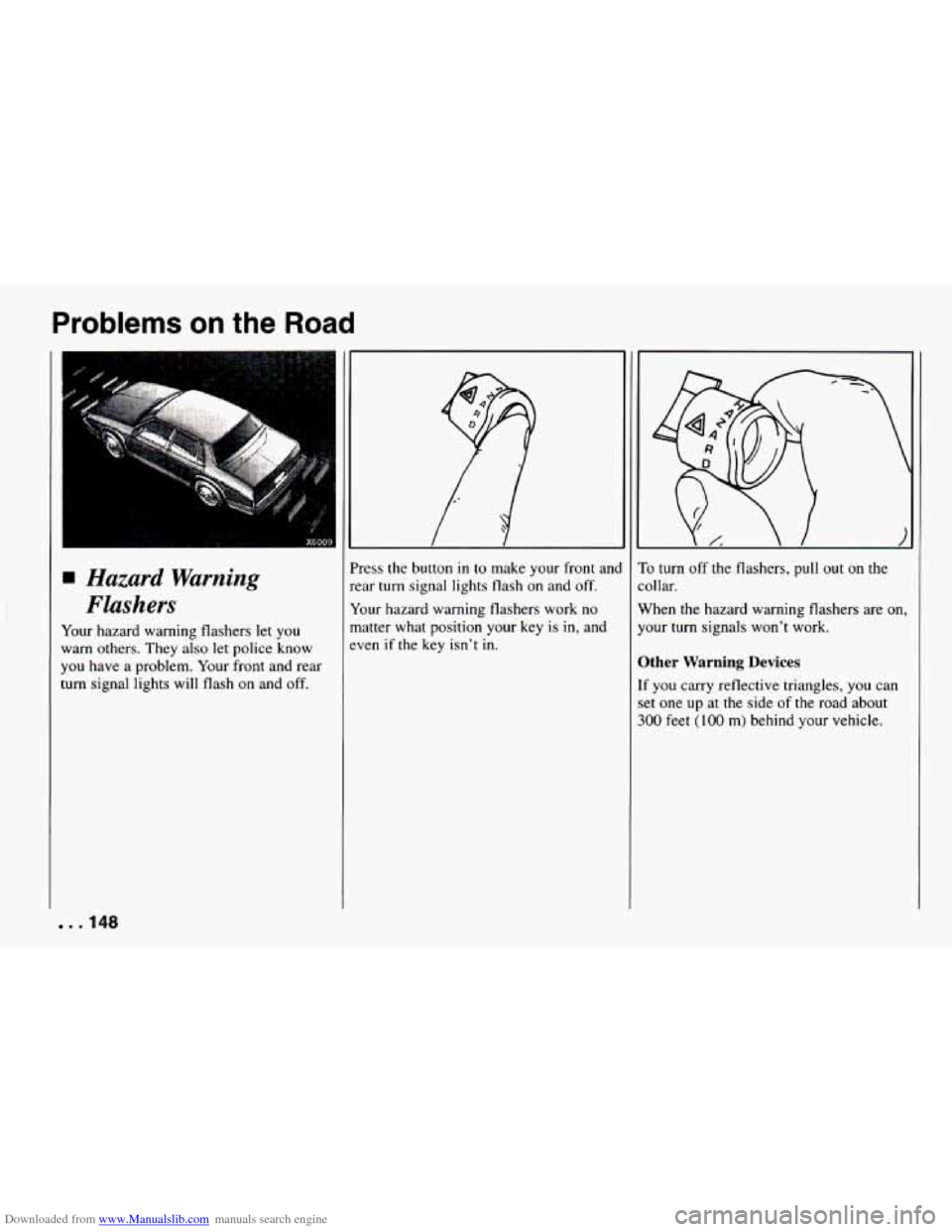
Downloaded from www.Manualslib.com manuals search engine Problems on the Road
Hazard Warning
Flashers
Your hazard warning flashers let you
warn others. They also
let police know
you have a problem. Your front and rear
turn signal lights will flash on and off. ’ress the button
in to make your front ant
ear turn signal lights
flash on and off.
(our hazard warning flashers work no
natter
what position your key is in, and
ven
if the key isn’t in.
i’I
C
V
Y
C
11
3
SI
b turn off the flashers, pull out on the
ol
1 ar.
Vhen the hazard warning flashers are on,
our turn signals won’t work.
Ither Warning Devices
f you carry reflective triangles, you can
et one up at the side of the road about
00 feet (100 m) behind your vehicle.
. ,148